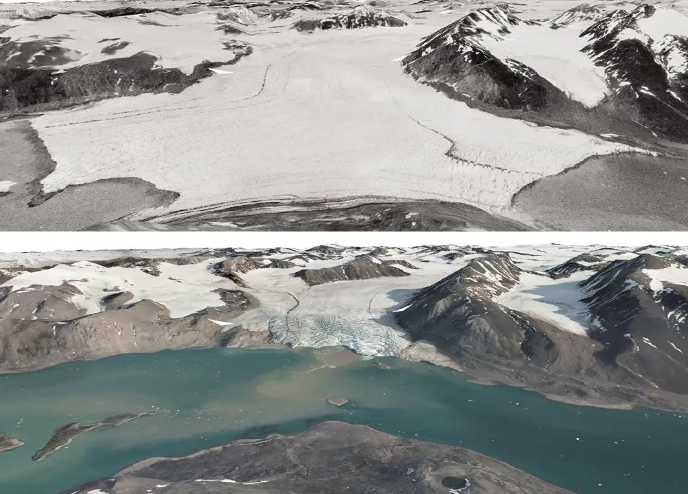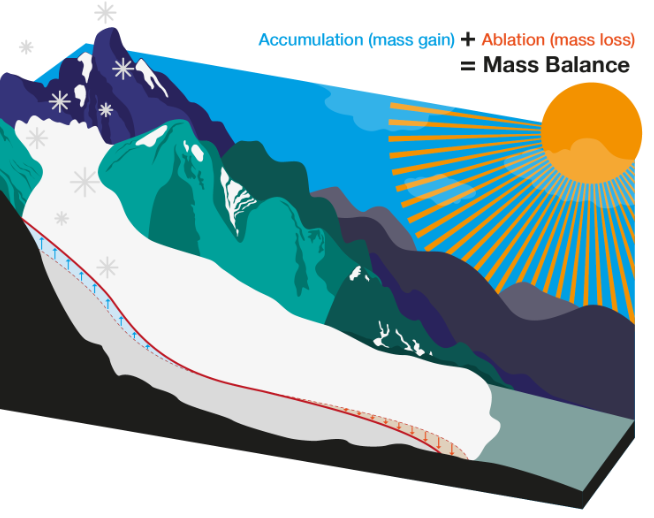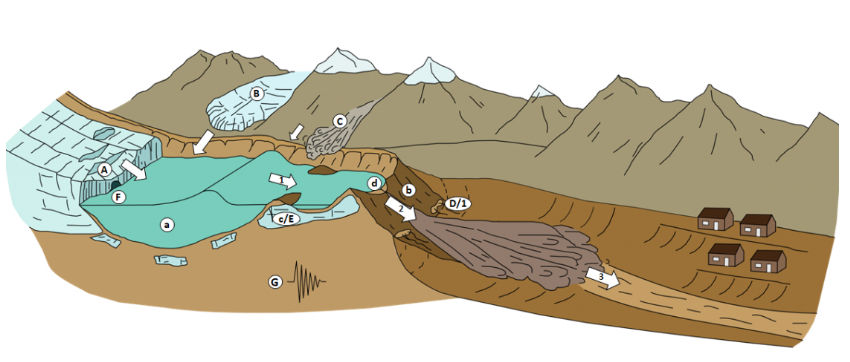Throughout the course of a staggering three million years, the canvas of Earth’s surface has been painted with a breathtaking symphony of climatic fluctuations—a dance between glaciations and warm interludes that have woven a mesmerizing tapestry of change. This geological ballet, with its crescendos of ice extending their icy fingers and ebbs of warmth embracing the landscapes, has sculpted a narrative that traverses epochs. A pivotal chapter in this saga narrates the peak glaciations—an epoch where a colossal expanse, spanning a staggering 47 million km2, lay beneath the formidable embrace of glaciers, a frozen tableau that dwarfed even the present-day ice shroud that envelops our planet.
These cyclic undulations, once attributed to nature’s subtle choreography as Earth pirouetted around the sun, have been etched into the very core of our planet’s history. The dance between the extremes was dictated by the celestial rhythms—variations in Earth’s orbital trajectory that orchestrated the ebb and flow of solar radiation. This natural melody conducted the evolution of our planet’s climate, shaping landscapes, guiding evolution, and defining the very essence of existence.
Yet, as humanity etched its mark upon the narrative of our planet, the tune of the ages began to waver. The indelible ink of human activity, the looming shadow of the greenhouse effect, has rewritten the score, altering the tempo of this timeless dance. The resplendent cadence of Earth’s climate, once guided by celestial symphonies, now finds itself swayed by a man-made symphony of carbon emissions, deforestation, and industrialization.
The Himalayan cryosphere, a glistening treasure trove of ice and snow, finds itself at the epicenter of this dramatic rewrite. The profound interplay between the cryosphere and global warming is a story that is unfolding before our eyes, a story woven from the delicate threads of temperature shifts, glacial retreats, and the melting embrace of ice. The frigid citadels that have stood sentinel for eons are now vulnerable, with their very existence hanging in the balance.
The Himalayas, a realm of breathtaking grandeur and untamed beauty, stands as both the harbinger and the victim of this unfolding saga. It is here, in the realm of towering peaks and hidden valleys, that the consequences of our actions resonate with the greatest intensity. The climatic dance, once harmonized with the celestial rhythms, now navigates the labyrinthine corridors of human choices, resonating with the call for action and the clarion call for preservation.
This juncture, where the echoes of history and the imperatives of the present converge, calls upon humanity to script a new chapter—a chapter where the symphony of change is once again orchestrated with harmony and reverence for the delicate balance that sustains our world. It’s a chapter where the Himalayan cryosphere regains its strength, where the majestic dance of glaciers is perpetuated, and where the legacy we leave behind for the ages tells a story of stewardship, renewal, and hope.
Glacial Retreat, Water Resources, and Biodiversity
The Impact of Global Warming
Global warming has accelerated since the beginning of the industrial revolution, resulting in an increase in global temperatures by approximately 0.6 ± 0.2°C since 1900. Greenhouse gases and aerosols in the atmosphere have caused an energy imbalance, leading to additional global warming of about 0.6°C even without further changes in atmospheric composition. Climate modeling projects a warming trend of 0.2°C per decade for the next two decades, regardless of greenhouse gas concentrations.
GLACIER RETREAT
Climate changes affect glaciers differently based on their size, altitude, orientation, and moraine cover. Monitoring changes in glacial extent is crucial for estimating the impact on water availability in the North Indian river system. Glacial boundaries and terminus identification play a vital role in retreat estimation. Glaciers that are not heavily covered by debris show distinct changes in their terminus morphology, indicating glacial retreat and reduced debris-carrying capacity.

Glacial Retreat in Himalayas
The intricate dance of glacial retreat unfolds with an astonishing diversity, a symphony of change conducted by the unique attributes of each glacier and the distinctive embrace of every basin. Amid this complex choreography, parameters such as maximum thickness, mass balance, and the rate of melting emerge as the architects of transformation, shaping the destiny of these frozen sentinels.
Consider the grand mosaic of glaciers that sprawl across the landscape, each boasting its own narrative of growth and decline. Here, size emerges as a pivotal player, and the tableau of climate change presents varied strokes of adaptation. Smaller glaciers, the nimble performers on this frigid stage, hold an advantage over their larger counterparts. With a response time that is inherently swifter, they are attuned to the heartbeat of climate shifts, adjusting their frozen contours with a certain agility.
This narrative of adaptation and response is a testament to nature’s finely tuned mechanisms. The ebb and flow of ice mirror the ebb and flow of time, an unending dialogue between the landscape and the elements. Amid this dialogue, the canvas of observation has unfurled a vivid panorama—one that paints the changes etched in the icy landscape. A poignant insight reveals the profound transformations witnessed between the years 1962 and 2001/02. Glaciers, dwarfed by a footprint of less than 1 km2, stand as living chronicles of this transformation, having relinquished nearly 38% of their icy embrace.
But it is not merely the numbers that weave this tale; it is the very essence of adaptability that imbues this narrative with its profound significance. The glaciers, regardless of their size, are the storytellers of Earth’s journey through time. Their responses, swift or measured, echo with a message that transcends their frozen nature—a message that speaks of the complex relationship between nature’s dynamics and humanity’s imprint.
As we stand witness to this unfolding drama, we bear witness to more than just the retreat of ice; we witness the very essence of adaptation and resilience. The glaciers, sculptors of the landscapes we cherish, mirror the intricate rhythms that define our world. Amid the cradle of ice, the echo of change is etched upon their contours, an eloquent testimony to the enduring relationship between Earth and sky, between humanity and its planet.
EFFECTS ON WATER RESOURCES
The Himalayan cryosphere plays a crucial role in the region’s water resources, acting as a natural reservoir. The glacial meltwater feeds major rivers, including the Ganges, Indus, and Brahmaputra, supplying water to millions of people downstream.
Impact on Water Availability
As the timeless sculptures of ice, the glaciers, embark on their poignant journey of retreat and dwindling volume, they initiate a cascade of effects that reverberate through the landscapes they once embraced. The transformation they undergo casts a spell on the very rivers they nurture, their once-frozen hearts melting and feeding the currents of change.
In the early stages of this glacial metamorphosis, a paradox unfolds—a surge of meltwater graces the rivers, imbuing them with a newfound vigor. This initial surge, akin to a river awakening from its icy slumber, can temporarily bolster the watercourses, gifting them with a momentary surge in flow. Yet, this apparent abundance is but a fleeting illusion, masking the deeper narrative that is etched upon the icy canvas.
As the glaciers continue their retreat, a disquieting shift takes root—an inevitable decline in meltwater contribution. This reduction in glacial mass, as the ice relinquishes its grasp on the landscape, echoes through the rivers in the form of diminished flow. The once-burgeoning currents, now diminished by the wane of glacial waters, mirror the changing rhythm of the natural world.
GLACIER MASS BALANCE
The delicate balance of glacier mass stands as a nuanced measure of nature’s response to the ebb and flow of time. This concept, known as glacier mass balance, encapsulates the intricate interplay between the accumulation and ablation of ice over the course of a hydrological year—an intricate choreography etched across the icy stage.
The endeavor to quantify this balance unfolds through a diverse array of methods, each revealing a unique facet of this frozen dance. Among them, the stalwart methodology of direct measurement takes center stage—a meticulous process that involves trekking into the heart of glacial realms, wielding instruments that render visible the gains and losses etched upon the ice. This hands-on approach, akin to deciphering nature’s cryptic language, captures the essence of change in the most tangible manner.
Photogrammetry emerges as another brushstroke upon this canvas—a technique that employs the art of imagery to glean insights. This visual voyage unveils the minute variations that escape the naked eye, capturing the subtle shifts in glacier mass with a photographic precision that resonates with the artistic essence of the Earth itself.
The hydrological method, with its calculations rooted in the intricate dance of water, unveils another layer of the glacier’s narrative. This approach, akin to deciphering a cryptic code hidden within the icy labyrinth, teases out the clues hidden in the flow of water—the lifeblood of the landscape.
In this symphony of methodologies, one cannot disregard the soaring significance of remote sensing. Like a sentinel poised in the heavens, these techniques cast an all-seeing eye upon the landscape, tracing the evolution of snow cover with a celestial gaze. During the ablation season, as the ice surrenders its grasp to the sun’s fervent touch, remote sensing techniques unfurl their wings, delivering insights that resonate across time and space.
As humanity stands on the threshold of a new era, armed with technology and wisdom, the tale of glacier mass balance takes on a new resonance. The glaciers, sculptors of the land, stand as a mirror to our changing world—a testament to the delicate equilibrium that governs our planet’s rhythms. Each methodology, each insight, unveils a fragment of this ever-unfolding narrative—a narrative that transcends science and resonates with the heartbeat of nature itself.
In this narrative, glacier mass balance is more than a concept; it is a bridge between the seen and the unseen, a testament to our ability to decipher the language of ice, and a reflection of the intricate web that binds humanity to the heart of the Earth. As we peer into this world of frozen wonder, we peer into the soul of our planet—a planet that whispers its secrets through the language of ice and time.

Estimating Glacial Mass Balance
Specific mass balance and accumulation area ratio (AAR) are used to estimate glacial mass balance. North-facing glaciers tend to have a relatively lower snow line at the end of the ablation season, leading to a higher accumulation area ratio. Glaciers located on northern slopes of the Pir Panjal mountain range show a higher accumulation area ratio due to their higher altitude and lower snow line.
IMPACT ON BIODIVERSITY
Global warming is threatening the unique biodiversity of the Himalayan region. Many species, especially those dependent on cold habitats, face the risk of extinction as their habitats shrink or vanish entirely.
Endangered Species and Habitats
Species like the Snow Leopard, Himalayan Musk Deer, and Red Panda are at risk due to loss of suitable habitats and reduced food availability. The loss of biodiversity can disrupt ecosystems and have cascading effects on other species.
GLACIAL LAKE OUTBURST FLOODS
In the unfolding narrative of our planet’s changing climate, the specter of global warming casts a long shadow, leaving no corner untouched by its transformative touch. Among the most poignant manifestations of this climatic shift is the rapid retreat of glaciers—a somber symphony composed of melting ice and the birth of glacial lakes. Yet, within this story lies a threat of cataclysmic proportions—an ever-looming specter known as Glacial Lake Outburst Floods (GLOFs).
As the earth’s temperature inches ever upward, the icy citadels of glaciers find themselves in retreat, surrendering their frozen expanse to the relentless march of warmth. This retreat births a delicate dance—the creation of glacial lakes. These bodies of water, nestled within the embrace of once-frozen landscapes, emerge as oases in a terrain sculpted by ice. But within their placid surfaces lurks a perilous secret—the potential for catastrophic floods, capable of unleashing devastation of unfathomable magnitude.
The mechanisms behind this threat are both intricate and hauntingly simple. The melting ice leaves behind depressions—a silent testament to the relentless march of climate change. These depressions become reservoirs, collecting water that once lay frozen. The danger emerges when the moraine dams—the natural barriers formed by debris and sediment—can no longer withstand the mounting pressure exerted by the accumulated water.
In these moments of vulnerability, the dams give way to the relentless force of nature. The result is a cataclysmic flood—a Glacial Lake Outburst Flood—where a torrent of water surges forth with an unrelenting fury. This deluge, a turbulent cascade of water and debris, can carve its path of destruction through valleys, obliterating everything in its wake.
The echoes of these events resonate across time and space, a haunting reminder of the delicate balance that governs our planet’s landscapes. In these stories of catastrophe, there lies a profound lesson—a lesson that underscores the interconnectedness of nature’s elements and humanity’s imprint. It is a lesson that speaks to the need for vigilance, for preparedness, and for a holistic approach to understanding the intricate dance of our world’s changing climate.
As we stand on the precipice of a future defined by climate uncertainty, the tales of Glacial Lake Outburst Floods serve as both a warning and a call to action. The retreat of glaciers and the birth of glacial lakes are not mere spectacles of change—they are the voices of our planet, urging us to navigate the currents of change with a reverence for the delicate balance that underpins our existence. It is a journey that demands our collective stewardship, our commitment to resilience, and our unyielding dedication to safeguarding the future.

GLOFs in the Himalayas
The Himalayas have experienced several GLOFs in the past, and the risk of future events is increasing with rising temperatures. Monitoring glacial lakes and implementing early warning systems are essential steps to mitigate the impact of GLOFs on downstream communities.
ADAPTATION STRATEGIES
In the face of climate change and its impact on the Himalayan cryosphere, adopting adaptive measures is crucial to mitigate the effects and build resilience.
Adapting to Climate Change
Efforts are being made to develop adaptation strategies that include sustainable water management, afforestation, community-based conservation, and the promotion of climate-resilient agriculture. These strategies aim to reduce vulnerability and enhance the region’s capacity to cope with climate-related challenges.
CONCLUSION
Global warming is significantly impacting the Himalayan cryosphere, resulting in glacial retreat, altered water resources, and threats to biodiversity. As the effects of climate change continue to intensify, urgent and collective actions are required to address this pressing issue. Through adaptation, conservation, and sustainable practices, we can protect the Himalayan cryosphere and secure a better future for the region and its inhabitants.
How does global warming contribute to glacial retreat in the Himalayas?
Global warming leads to higher temperatures, causing glaciers to melt at accelerated rates. This increased melting results in glacial retreat and a reduction in glacial mass over time.
What are the potential consequences of glacial lake outburst floods (GLOFs)?
Glacial lake outburst floods can have devastating consequences downstream. They can cause massive destruction to infrastructure, agricultural lands, and human settlements, posing risks to human lives and livelihoods.
How can communities adapt to the changing conditions in the Himalayan region?
Communities can adapt by implementing sustainable water management practices, promoting climate-resilient agriculture, conserving biodiversity, and establishing early warning systems for glacial lake outburst floods.
